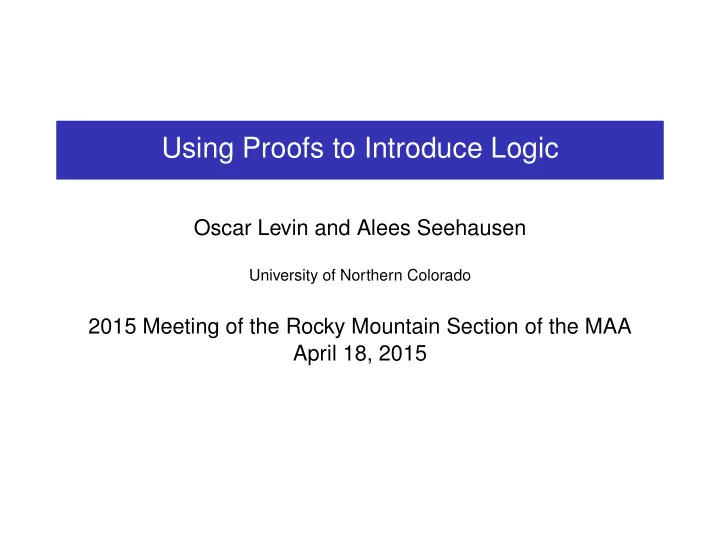

Using Proofs to Introduce Logic Oscar Levin and Alees Seehausen University of Northern Colorado 2015 Meeting of the Rocky Mountain Section of the MAA April 18, 2015
Background Discrete Mathematics (Math 228) at UNC is (essentially) our bridge course. Students: mostly pre-service math teachers. Topics: Counting, Sequences, Graph Theory, Logic & Proofs.
Logic & Proofs We spent 2 weeks on the subject in the middle of the semester. Goals for logic: Survey logic as a topic in mathematics. Truth-tables, logical equivalence, deduction rules. Predicate logic and quantifiers. Converse, contrapositive, negation. Goals for proofs: Introduce styles of proof and conventions. Direct proof, proof by contrapositive, proof by contradiction. Induction & combinatorial proofs (done earlier). Improve mathematical writing. Personal goal: Students will see the connection between logic and proofs.
(Almost) Introductory Activity Students are given four “proofs” for the statement, If ab is even, then a is even or b is even. Students decide (in groups) which of the proofs are valid. Give it a try!
1 and 2 1 Suppose a = 2 k + 1 ( a is odd) and b = 2 m + 1 ( b is odd). Then ab = ( 2 k + 1 )( 2 m + 1 ) = 4 km + 2 k + 2 m + 1 = 2 ( 2 km + k + m ) + 1 which proves that ab is odd if a and b are odd. Therefore, if ab is even, then a or b is be even. 2 Assume that a or b is even - say it is a . That is, a = 2 k for some integer k . Then ab = ( 2 k ) b = 2 ( kb ) which means that ab is even. The case where b is even is identical. Therefore, if ab is even then a is even or b is even. Students consensus: 1 is invalid, 2 is valid.
Logic to the rescue Translate: “If ab is even, then a is even or b is even” P → ( Q ∨ R ) P → S In proof 1: we assume ¬ Q ∧ ¬ R (i.e., ¬ S ) and deduce ¬ P . ∴ ( ¬ Q ∧ ¬ R ) ¬ S → ¬ P In proof 2: we assume Q ∨ R and deduce P . ∴ S → P
By contradiction 3 Suppose that ab is even but a and b are both odd. Namely, ab = 2 n , a = 2 k + 1 and b = 2 j + 1 for some integers n , k , and j . Then 2 n = ( 2 k + 1 )( 2 j + 1 ) 2 n = 4 kj + 2 k + 2 j + 1 n = 2 kj + k + j + 1 2 But since 2 kj + k + j is an integer, this says that the integer n is equal to a non-integer, which is impossible. Therefore, if ab is even then a or b must be even. Note: what is the assumption? P ∧ ( ¬ Q ∧ ¬ R ) ≡ ¬ ( P → ( Q ∨ R ))
Another one 4 Let ab be an even number, say ab = 2 n , and a be an odd number, say a = 2 k + 1 . Then ab = ( 2 k + 1 ) b 2 n = 2 kb + b 2 n − 2 kb = b 2 ( n − kb ) = b Therefore b must be even. P → ( Q ∨ R ) ≡ ( P ∧ ¬ Q ) → R
The good Naturally motivated logic. Students took ownership. Illustrated connection between logic and proofs. Highlighted standard proof formats from the right direction.
The bad Long activity. Confusion over Q ∨ R vs S . Students hung up on algebra and meaning of even/odd. Statements about parity are trivial and boring.
Some fixes If ab is even, then a is evenis even or b is even. Clean up proofs to make assumptions and conclusions obvious. Think up more interesting statement (under construction) Other ideas?
Thanks! Slides and handout: discretetext.oscarlevin.com/talks.php
Recommend
More recommend